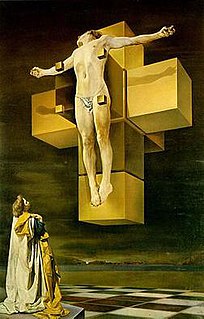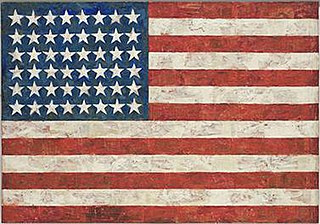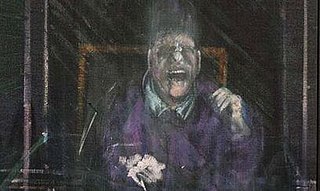 W
WThe Bar is a 1954 painting by Australian artist John Brack. The subject of the painting directly references Édouard Manet's 1882 work A Bar at the Folies-Bergère. It depicts a barmaid working in an Australian pub at the time of the "six o'clock swill". As in Manet's work, the patrons of the bar are shown in a reflection behind the barmaid. The work is considered a companion piece to Brack's 1955 work Collins St., 5 pm.
 W
WThe Block is a 1954 painting by Australian artist John Brack. The painting depicts the interior of an empty butcher's shop, including the eponymous butcher's block. It is one of a series of paintings—including The Barber's Shop (1952), The Fish Shop (1955) and Men's Wear (1955)—of small high street businesses.The tools of the trade – choppers, knives and meathooks – hang from the rails. The butcher’s block, centrally placed and painted in a darker tone, dominates the composition. Despite the rather grisly subject matter, Brack has achieved a small, perfectly contained and beautifully painted jewel-like interior. The detail of the brushwork, with its meticulous lines and opaque passages of thin paint in the background, the fine scratches incised into the block to indicate its use, and the artist’s handmade wooden frame, all converge in an exquisite synthesis
 W
WBreaking Home Ties is a painting by American illustrator Norman Rockwell, created for the September 25, 1954, cover of The Saturday Evening Post. The picture represents a father and son waiting for a train that will take the young man to the state university. The painting, considered by experts to be one of Rockwell's masterworks, is also one of the most widely reproduced, and was voted the second-most popular image in Post history.
 W
WThe Colossus of Rhodes is a 1954 oil painting by the Spanish surrealist artist Salvador Dalí. It is one of a series of seven paintings created for the 1956 film Seven Wonders of the World, each depicting one of the eponymous wonders. The painting shows the Colossus of Rhodes, the ancient statue of the Greek titan-god of the sun, Helios. It was ultimately not used for the movie, and in 1981 was donated to the Kunstmuseum Bern, its present location.
 W
WCrucifixion is a 1954 oil-on-canvas painting by Salvador Dalí. A nontraditional, surrealist portrayal of the Crucifixion, it depicts Christ on the polyhedron net of a tesseract (hypercube). It is one of his best-known paintings from the later period of his career.
 W
WLa Desintegración de la Persistencia de la Memoria or The Disintegration of the Persistence of Memory is an oil on canvas painting by the Spanish surrealist Salvador Dalí. It is a 1954 re-creation of the artist's famous 1931 work The Persistence of Memory, and measures a diminutive 25.4 × 33 cm. It was originally known as The Chromosome of a Highly-coloured Fish's Eye Starting the Harmonious Disintegration of the Persistence of Memory, and first exhibited at the Carstairs Gallery in New York in 1954.
 W
WThe Empire of Light is a series of paintings René Magritte covered more than a dozen times from 1947 to 1965. They depict the paradoxical image of a nighttime street, lit only by a single street light, beneath a daytime sky. In this case the artist was inspired by the works of John Atkinson Grimshaw, an English painter from the Victorian era, who had delighted in his time to paint urban views at sunset.
 W
WFigure with Meat is a 1954 painting by the Irish-born artist Francis Bacon. The figure is based on the Pope Innocent X portrait by Diego Velázquez; however, in the Bacon painting the Pope is shown as a gruesome figure and placed between two bisected halves of a cow.
 W
WFlag is an encaustic painting by the American artist Jasper Johns. Created when Johns was 24 (1954–55), two years after he was discharged from the US Army, this painting was the first of many works that Johns has said were inspired by a dream of the U.S. flag in 1954. It is arguably the painting for which Johns is best known.
 W
WLa Gloriosa Victoria is a 1954 painting by Diego Rivera.
 W
WThe Kentuckian is a 1954 painting by the American artist Thomas Hart Benton. It is based on a scene from the film The Kentuckian, where the backwoodsman Big Eli Wakefield and his son Little Eli encounter a frontier village. The painting belongs to the Los Angeles County Museum of Art.
 W
WNo 1 is a 1954 Color Field painting by the Abstract expressionist artist Mark Rothko. In November 2012, the painting sold for US$75.1 million (£47.2m) at a Sotheby's auction.
 W
WSunflower is a painting by Romanian artist Ion Țuculescu from 1954.
 W
WIn 1954 the English artist Graham Sutherland was commissioned to paint a full-length portrait of Prime Minister Sir Winston Churchill of the United Kingdom. Sutherland received 1,000 guineas in compensation for the painting, a sum funded by donations from members of the House of Commons and House of Lords. The painting was presented to Churchill by both Houses of Parliament at a public ceremony in Westminster Hall on his 80th birthday on 30 November 1954.
 W
WSylvette is the title of a portrait painting by Pablo Picasso, featuring a young woman with a pony tail. The model for the painting, Lydia Sylvette David, also known by her married name Lydia Corbett, was a French woman who, during the summer of 1953, worked in a pottery studio near Picasso's studio in Vallauris. Finding her appearance appealing, Picasso created 40 works inspired by her. Sylvette's portrait from 2 May 1954 is one of the last of a long series.
 W
WUntitled (Pope) is a circa 1954 oil on canvas panel painting by the Irish born, English artist Francis Bacon, one in a series of many representations of popes he painted after Diego Velázquez's 1650 Portrait of Innocent X. Bacon was a harsh self-critic and destroyed a great many of his own paintings, many of which were created under the influence of drink. This work was long thought lost until it reemerged on the art market in 2016. It is closely related to Bacon's masterpiece, the Study after Velázquez's Portrait of Pope Innocent X in the Des Moines Art Center, Iowa.
 W
WYoung Virgin Auto-Sodomized by the Horns of Her Own Chastity is a 1954 painting by Salvador Dalí. During the 1950s, Dalí painted many of his subjects as composed of rhinoceros horns. Here, the young virgin's buttocks consist of two converging horns and two horns float beneath; "as the horns simultaneously comprise and threaten to sodomise the callipygian figure, she is effectively (auto) sodomised by her own constitution."